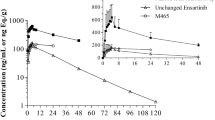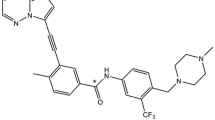Abstract
Purpose
Envonalkib (TQ-B3139) is a novel, potent anaplastic lymphoma kinase (ALK) tyrosine kinase inhibitor used to treat ALK-positive non-small cell lung cancer. This phase I mass balance study investigated the pharmacokinetics, metabolism, and excretion of 14C-radiolabeled envonalkib in healthy Chinese male subjects.
Methods
A single oral dose of 600 mg (150 µCi) [14C]envonalkib was administered to healthy male subjects under fasted state. Samples of blood, urine and feces were collected for quantitative determination of total radioactivity and unchanged envonalkib, and the metabolites identification.
Results
After dosing, the median Tmax of radioactivity was 4 h and the mean t1/2 was 65.2 h in plasma. The exposure of total radioactivity was much higher than that of unchanged envonalkib in plasma. The mean total recovery of the radiolabeled dose was 93.93% over 504 h post-dose, with 15.23% in urine and 78.71% in feces. Envonalkib underwent extensive metabolism and a total of 15 metabolites were identified in plasma, urine, and feces. Unchanged envonalkib and its major metabolite M315 were the main components in plasma, accounting for 20.37% and 33.33% of total plasma radioactivity. In urine, O-dealkylation metabolite M315 was the major component accounted for 7.98% of dose. In feces, 16.01% of dose was excreted as cysteine conjugate M434-1. Envonalkib was well tolerated and there were no serious adverse events observed in the study.
Conclusion
Envonalkib was extensively metabolized prior to excretion and eliminated primarily as metabolites via feces.





Similar content being viewed by others
Data availability
The authors confirm that the data supporting the findings of this study are available within the article.
References
Planchard D, Popat S, Kerr K, Novello S, Smit EF, Faivre-Finn C, Mok TS, Reck M, Van Schil PE, Hellmann MD, Peters S, ESMO Guidelines Committee (2018) Metastatic non-small cell lung cancer: ESMO Clinical Practice Guidelines for diagnosis, treatment and follow-up. Ann Oncol 29(Suppl 4):iv192–iv237. https://doi.org/10.1093/annonc/mdy275
Tian HX, Zhang XC, Yang JJ, Guo WB, Chen ZH, Wang Z, Wu YL (2017) Clinical characteristics and sequence complexity of anaplastic lymphoma kinase gene fusions in Chinese lung cancer patients. Lung Cancer 114:90–95. https://doi.org/10.1016/j.lungcan.2017.11.001
Chen J, Xu C, Lv J, Lu W, Zhang Y, Wang D, Song Y (2023) Clinical characteristics and targeted therapy of different gene fusions in non-small cell lung cancer: a narrative review. Transl Lung Cancer Res 12(4):895–908. https://doi.org/10.21037/tlcr-22-566
Shaw AT, Kim DW, Nakagawa K, Seto T, Crino L, Ahn MJ, De Pas T, Besse B, Solomon BJ, Blackhall F, Wu YL, Thomas M, O’Byrne KJ, Moro-Sibilot D, Camidge DR, Mok T, Hirsh V, Riely GJ, Iyer S, Tassell V, Polli A, Wilner KD, Janne PA (2013) Crizotinib versus chemotherapy in advanced ALK-positive lung cancer. N Engl J Med 368(25):2385–2394. https://doi.org/10.1056/NEJMoa1214886
Hirota T, Muraki S, Ieiri I (2019) Clinical pharmacokinetics of anaplastic lymphoma kinase inhibitors in non-small-cell lung cancer. Clin Pharmacokinet 58(4):403–420. https://doi.org/10.1007/s40262-018-0689-7
Zia V, Lengyel CG, Tajima CC, de Mello RA (2023) Advancements of ALK inhibition of non-small cell lung cancer: a literature review. Transl Lung Cancer Res 12(7):1563–1574. https://doi.org/10.21037/tlcr-22-619
Wang L, Gao M, Tong M, Xie C, He Y, Fu L, Li Y, Fu H, Lou L (2018) Pharmacologic characterization of CT-711, a novel dual inhibitor of ALK and c-Met. Am J Cancer Res 8(8):1541–1550
Ma Y, Zhao H, Xue J, Liu L, Yang N, Zhang Y, Yang H, Hong S, Xiong Y, Zhang Z, Zeng L, Pan H, Zhou C, Zhang Y, Wang X, Han X, Wan X, Shao Y, Liu J, Yang Y, Huang Y, Zhao Y, Fang W, Li S, Zhang L (2022) First-in-human phase I study of TQ-B3139 (CT-711) in advanced non-small cell lung cancer patients with ALK and ROS1 rearrangements. Eur J Cancer 173:238–249. https://doi.org/10.1016/j.ejca.2022.06.037
Yang Y, Min J, Yang N, Yu Q, Cheng Y, Zhao Y, Li M, Chen H, Ren S, Zhou J, Zhuang W, Qin X, Cao L, Yu Y, Zhang J, He J, Feng J, Yu H, Zhang L, Fang W (2023) Envonalkib versus crizotinib for treatment-naive ALK-positive non-small cell lung cancer: a randomized, multicenter, open-label, phase III trial. Signal Transduct Target Ther 8(1):301. https://doi.org/10.1038/s41392-023-01538-w
Hop CE, Wang Z, Chen Q, Kwei G (1998) Plasma-pooling methods to increase throughput for in vivo pharmacokinetic screening. J Pharm Sci 87(7):901–903. https://doi.org/10.1021/js970486q
Penner N, Klunk LJ, Prakash C (2009) Human radiolabeled mass balance studies: objectives, utilities and limitations. Biopharm Drug Dispos 30(4):185–203. https://doi.org/10.1002/bdd.661
Johnson TR, Tan W, Goulet L, Smith EB, Yamazaki S, Walker GS, O’Gorman MT, Bedarida G, Zou HY, Christensen JG, Nguyen LN, Shen Z, Dalvie D, Bello A, Smith BJ (2015) Metabolism, excretion and pharmacokinetics of [14C]crizotinib following oral administration to healthy subjects. Xenobiotica 45(1):45–59. https://doi.org/10.3109/00498254.2014.941964
Tan W, Yamazaki S, Johnson TR, Wang R, O’Gorman MT, Kirkovsky L, Boutros T, Brega NM, Bello A (2017) Effects of renal function on crizotinib pharmacokinetics: dose recommendations for patients with ALK-positive non-small cell lung cancer. Clin Drug Investig 37(4):363–373. https://doi.org/10.1007/s40261-016-0490-z
Zhou S, Liu W, Zhou C, Zhang L, Xie L, Xu Z, Wang L, Zhao Y, Guo L, Chen J, Ding L, Mao L, Tao Y, Zhang C, Ding S, Shao F (2020) Mass balance, metabolic disposition, and pharmacokinetics of [14C]ensartinib, a novel potent anaplastic lymphoma kinase (ALK) inhibitor, in healthy subjects following oral administration. Cancer Chemother Pharmacol 86(6):719–730. https://doi.org/10.1007/s00280-020-04159-0
Morcos PN, Yu L, Bogman K, Sato M, Katsuki H, Kawashima K, Moore DJ, Whayman M, Nieforth K, Heinig K, Guerini E, Muri D, Martin-Facklam M, Phipps A (2017) Absorption, distribution, metabolism and excretion (ADME) of the ALK inhibitor alectinib: results from an absolute bioavailability and mass balance study in healthy subjects. Xenobiotica 47(3):217–229. https://doi.org/10.1080/00498254.2016.1179821
Hsu JC, Carnac R, Henschel V, Bogman K, Martin-Facklam M, Guerini E, Balas B, Zeaiter AH, Phipps A, Morcos PN, Frey N (2016) Population pharmacokinetics (popPK) and exposure-response (ER) analyses to confirm alectinib 600 mg BID dose selection in a crizotinib-progressed or intolerant population. J Clin Oncol 34(15_suppl):e20598–e20598. https://doi.org/10.1200/JCO.2016.34.15_suppl.e20598
Gupta N, Wang X, Offman E, Prohn M, Narasimhan N, Kerstein D, Hanley MJ, Venkatakrishnan K (2021) Population pharmacokinetics of brigatinib in healthy volunteers and patients with cancer. Clin Pharmacokinet 60(2):235–247. https://doi.org/10.1007/s40262-020-00929-4
Lin S, Gong J, Canas GC, Winkle P, Pelletier K, LaBadie RR, Ginman K, Pithavala YK (2022) A phase I study to evaluate the pharmacokinetics and safety of lorlatinib in adults with mild, moderate, and severe renal impairment. Eur J Drug Metab Pharmacokinet 47(2):235–245. https://doi.org/10.1007/s13318-021-00747-4
Stypinski D, Fostvedt L, Lam JL, Vaz A, Johnson TR, Boerma JS, Pithavala YK (2020) Metabolism, excretion, and pharmacokinetics of lorlatinib (PF-06463922) and evaluation of the impact of radiolabel position and other factors on comparability of data across 2 ADME studies. J Clin Pharmacol 60(9):1254–1267. https://doi.org/10.1002/jcph.1621
US Food and Drug Administration (2016) Safety testing of drug metabolites, guidance for industry. https://www.fda.gov/media/72279/download. Accessed March 2020
US Food and Drug Administration (2003) Pharmacokinetics in patients with impaired hepatic function: study design, data analysis, and impact on dosing and labeling. https://www.fda.gov/media/71311/download. Accessed May 2003
Acknowledgements
The authors are thankful to Shanghai Institute of Materia Medica for the bioanalysis in this study.
Funding
Xin Wang, Xiaojing Wan, Dawei Ding, Ding Yu, Xunqiang Wang are employees of Chia Tai Tianqing Pharmaceutical Group Co., Ltd. which provided funding for this study.
Author information
Authors and Affiliations
Contributions
SM, LYM and HZ designed and executed this study. XJW, DWD, DY and XQW supported this study. SY and XXD performed bioanalysis. XW wrote the main manuscript text. All authors reviewed the manuscript.
Corresponding authors
Ethics declarations
Conflict of interest
The authors declare no conflicts of interest.
Ethical approval
The studies involving humans were approved by the Medical Ethics Committee of the First Affiliated Hospital of Soochow University (Approval No.: 2021308). All procedures performed in studies involving human participants were in accordance with ethical principles of the Helsinki Declaration. This article does not contain any studies with animals performed by any of the authors.
Informed consent
All participants provided written informed consent prior to any study-related procedures.
Additional information
Publisher's Note
Springer Nature remains neutral with regard to jurisdictional claims in published maps and institutional affiliations.
Clinical Trial Registration: CTR20220526.
Rights and permissions
Springer Nature or its licensor (e.g. a society or other partner) holds exclusive rights to this article under a publishing agreement with the author(s) or other rightsholder(s); author self-archiving of the accepted manuscript version of this article is solely governed by the terms of such publishing agreement and applicable law.
About this article
Cite this article
Ma, S., Wang, X., Yan, S. et al. Pharmacokinetics, mass balance, and metabolism of [14C]envonalkib (TQ-B3139), a novel ALK tyrosine kinase inhibitor, in healthy Chinese subjects. Cancer Chemother Pharmacol (2024). https://doi.org/10.1007/s00280-024-04647-7
Received:
Accepted:
Published:
DOI: https://doi.org/10.1007/s00280-024-04647-7




